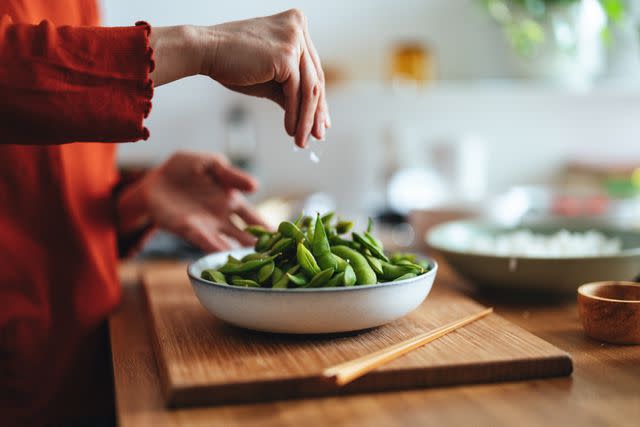Guide to Increasing Estrogen With Fluctuating Hormone Levels
Foods, Herbs, and Hormone Therapy to Consider
Medically reviewed by Kelly Wood, MD
In perimenopause, estrogen levels can fluctuate greatly, with the hormone eventually declining to very low levels once menopause is reached. Fluctuating and low levels of estrogen can cause an array of symptoms that can affect quality of life.
Both men and women can experience low estrogen levels, although it is much less common in men. Certain foods, supplements, and herbs can help raise estrogen levels naturally. Estrogen levels can also be raised with hormone therapy (HT).
This article looks at natural and synthetic options for raising estrogen levels, along with symptoms of low, high, and balanced estrogen.

miniseries / Getty Images
How To Increase Estrogen Through Diet
Phytoestrogens are compounds found in plants with a molecular structure similar to the estrogen hormone. Eating foods or taking herbal supplements with phytoestrogens can mimic the effects of estrogen in the body and may help increase estrogen levels in postmenopausal women.
Foods
It is possible to raise or lower your estrogen level through food. Some foods with phytoestrogen may help increase estrogen levels.
Soy: The richest source of phytoestrogen, known as isoflavones, is found in soybeans and processed products with soy. Phytoestrogen levels in pure soybeans are higher than in processed food containing soy.
Soy has been found to increase the effects of estrogen in menopausal women and decrease its effects in premenopausal women. Regular soy consumption does not appear to affect estrogen levels in men.
Lignan-rich foods: Lignans are phytoestrogens found in plant-based foods that have weak estrogenic activity but can also mimic the effects of estrogen through other biological methods. Many fruits, vegetables, nuts, whole grains, and seeds contain lignans.
Foods that contain lignans include:
Flaxseeds (very high lignan content)
Sesame seeds
Curly kale
Kidney beans
Chickpeas
Peas
Lentils
Peanuts
Berries
Coffee and tea
Stilbene and coumestan are two other categories of phytoestrogens. Foods with these phytoestrogens include:
Herbs
Certain herbs also contain phytoestrogens. However, some phytoestrogens found in herbal supplements often have much higher doses than those found in foods and can have potential side effects, some of them serious. Do not take any herbal supplement before consulting with a healthcare practitioner.
Some of the most common herbal supplements to increase estrogen levels are:
Black cohosh: Studies have produced conflicting results regarding whether black cohosh raises estrogen levels in the body, and its estrogen-like effects may come through other biological mechanisms.
Chasteberry (vitex): This berry, commonly found in supplement form, has been shown to increase estrogen and progesterone levels in menopausal women.
Red clover: Although there has been conflicting research on this phytoestrogen's effectiveness in increasing estrogen, one study found that red clover may help raise estrogen levels and alleviate hot flashes in menopausal women.
Supplements
Certain supplements, such as vitamins E and D, may also help increase estrogen levels.
Vitamin E contains phytoestrogens and has been found to help alleviate certain menopausal symptoms, including hot flashes, vasomotor symptoms, and vaginal changes. Although vitamin E is not as effective as hormone therapy in relieving menopausal symptoms, it can be effective when used in addition to HT.
Estrogen and vitamin D perform similar physiological functions, mainly supporting bone health. Low levels of vitamin D have been linked with low levels of estrogen, while higher levels of vitamin D have been linked with higher estrogen levels in women. Studies have suggested vitamin D supplementation may help increase estrogen levels in postmenopausal women.
Why Can Men Have Low Estrogen?
Although uncommon, men can have low estrogen due to hypogonadism, which decreases the production of hormones. Hypogonadism in men can be caused by problems with the testicles from an injury or infection, pituitary conditions, congenital conditions, certain cancer treatments, or aging. Treatments for low estrogen in men should be discussed with a healthcare provider.
How to Increase Estrogen with Medication
Hormone therapy uses prescription drugs to increase estrogen levels. The two types of HT for estrogen are:
Systemic estrogen therapy: This type of HT uses pills, skin patches, gels, or sprays that release estrogen into the bloodstream so it can travel to organs and tissues throughout the body.
Local estrogen therapy: A vaginal ring, tablet, or cream is used to release small doses of estrogen directly into vaginal tissue. This therapy is usually used to treat vaginal dryness.
Does Anything Raise Estrogen Quickly?
Estrogen levels cannot always be raised quickly and may take some time to increase, even with HT. Although many people begin to feel symptoms decrease fairly soon after starting HT, it can take up to three months for symptoms to improve.
Symptoms of Low Estrogen
Symptoms of low estrogen levels include:
Hot flashes
Headaches/migraines
Fatigue
Brain fog or trouble concentrating
Vaginal dryness
Decreased interest in sex
Symptoms of High Estrogen
Symptoms of having too much estrogen include:
Bloating
Breast tenderness
Spotting or heavy bleeding
Symptoms of Balanced Estrogen
If estrogen is balanced, you shouldn't have symptoms of either low or high levels. Balanced estrogen can help boost mood, focus, and memory, promoting healthy blood pressure and cholesterol levels.
Summary
Low estrogen levels occur during perimenopause and menopause and can cause a wide array of unpleasant symptoms that can affect quality of life. Estrogen levels can be raised naturally through foods and supplements that contain phytoestrogens, along with certain supplements, although their effectiveness can vary.
Hormone therapy using estrogen pills, patches, creams, or gels is known to be effective at raising estrogen levels and reducing symptoms of low estrogen levels.
Read the original article on Verywell Health.

